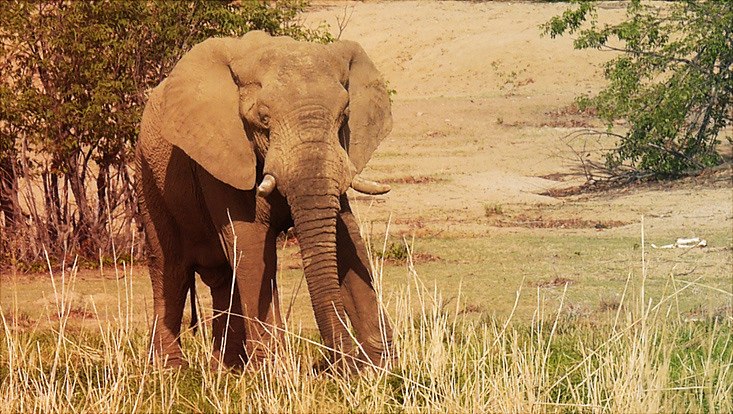Water shortages! When climate change drives elephants to the villages
21 November 2018, by Prof. Dr. Michael Schnegg

Photo: UHH/M.Schnegg
The rumbling could be heard for miles. A herd of African elephants was headed for the small Namibian village that I stayed at during my research visits. Elephants normally avoid the villages, but we could guess what they were searching for on that afternoon. They could pick up the scent from far away: water.

The people in the Kunene region tell me that elephant herds are now descending on villages more and more frequently. But why? As an ethnologist at Universität Hamburg’s Cluster of Excellence for climate research, I investigate questions like this together with my colleague Richard Dimba Kiaka. To do so, we regularly spend extended periods living under conditions that are as similar as possible to those of the Damara families in the region: in simple huts without electricity or running water. I can now speak and understand the language my neighbors use – with its characteristic clicks – relatively well.

The people here are mainly livestock farmers, and they build large water reservoirs for their goats and cattle – which are like magnets for the desperate elephants. Namibia is in the far south of Africa and is one of the continent’s most arid countries; several months can pass without a drop of rain. There are only about 60 days a year with any precipitation at all – compared to Hamburg, which has 180 days on average. Actually, the elephants are used to these conditions and search for water in dried-up riverbeds, digging down to depths of up to three feet, where they often find seeped water.

But in recent years, the water table has sunk, and the elephants are unable to find enough water. Moreover, an unusually long drought between 2013 and 2017 exacerbated the water shortage, forcing the animals into the villages. Like on that afternoon when we had no choice but to barricade ourselves in our huts. We could hear the destruction going on for several hours before the herd finally moved on. They had torn open the village reservoir, since the baby elephants’ trunks couldn’t reach over the edge. The pumps and troughs, water cans and vegetable plots were destroyed – the entire village infrastructure had suffered serious damage.
Is climate change to blame for the increased number of “elephant invasions?” That would fit to the forecasts issued by the IPCC, according to which the African continent will be hardest hit by climate changes. The average temperature will rise there more than in the rest of the world. And while precipitation could increase in central Africa, in northern and southern Africa it is likely to decrease further. But that’s only half the picture.
Around the globe, elephants are an endangered species. In 1900, there were estimated to be several million – today there’s only a fraction of that number. But the story is very different in the Kunene region: The number of elephants has doubled in the last 20 years – good news for wildlife conservationists. The government created nature conservation areas where elephants are protected from hunters, allowing them to reproduce undisturbed. The exotic animals also attract tourists – and the industry is booming. However, the money mainly goes to businesses in the capital, Windhoek. The state profits from tax revenues; but very little money makes its way to the rural population.
As a remedy the state could e.g. tax tourism more heavily in order to compensate the locals for damages. This would be a first step toward ensuring that, in an era of climate change, nature conservation doesn’t further worsen inequalities.
Scientific paper: Subsidized elephants: Community-based resource governance and environmental (in)justice in Namibia; Schnegg, Michael; Kiaka, Richard Dimba (2018)
Prof. Michael Schnegg is an anthropologist and member of the Cluster of Excellence CliSAP, where he is currently investigating the impact of climate change on rural regions in Africa.
This article was first published as a guest article in the Hamburger Abendblatt as part of a monthly series on climate research. Here you can find more articles of the series.


